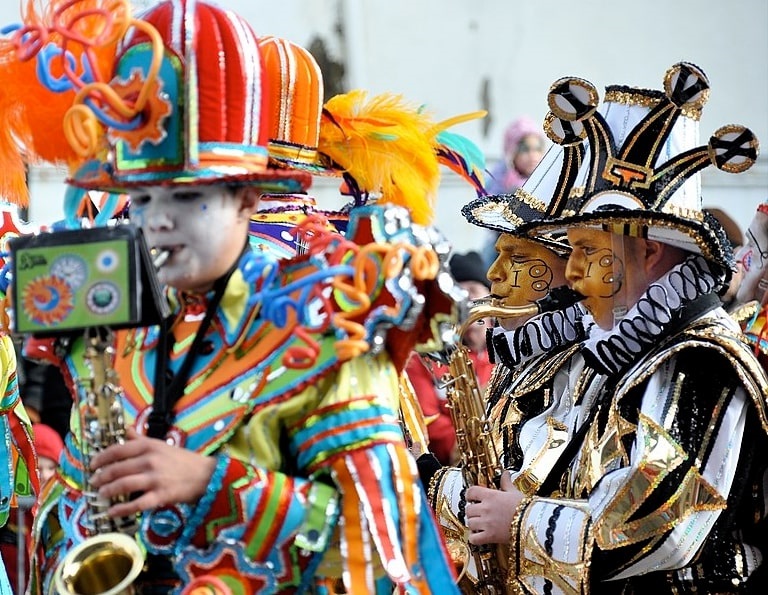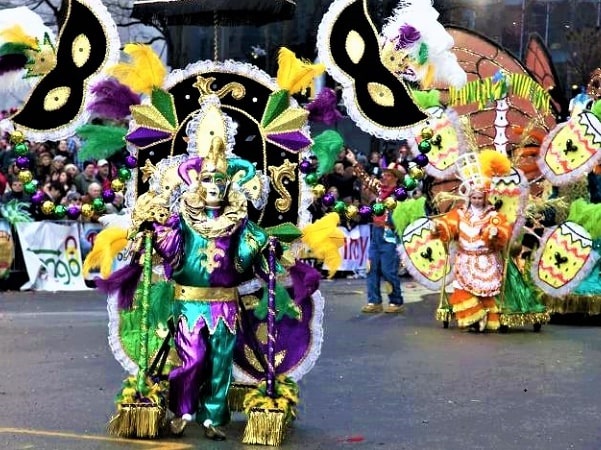Introduction: In this article, Melissa Davenport Berry describes how Philadelphia celebrates New Year’s Day – with the fantastic Mummers Parade, the “Mardi Gras of the North.” Melissa is a genealogist who has a blog, AnceStory Archives, and a Facebook group, New England Family Genealogy and History.
When it comes to ringing in the New Year for the city of Philadelphia, “Mum’s the word.” The annual New Year’s Day Mummers Parade draws a crowd and is loads of fun. It is a cherished event and remains one of the oldest folk traditions in America. It also called “the Mardi Gras of the North.”

The day is packed with magic: hours of bands, comic and fancy brigades, and theatrical floats, and it’s not every day you get to see your local fireman or mechanic dressed in women’s garb sporting stilettos.
According to various sources, the Mummers Parade was birthed in Philadelphia before the Civil War, when dwellers in the lower part of the town, the “Neck,” paraded the streets in fantastic garb, welcoming the New Year by shooting revolvers and firing off cannon crackers. The celebrants are still known today as the “shooters.”
“Mummers” is a term that has been in use in the British Isles since the Middle Ages, and refers to costumed amateur actors performing in folk plays.
The original “shooters” made their way through Philadelphia’s streets while bands played loudly, then would slow down periodically with softer tunes while the leader shot out such verses as:
“Here we stand before your door,
As we stood the year before;
Give us whiskey, give us gin,
Open the door and let us in!”
The carnivalesque atmosphere derives from a combination of many customs, but the most widely known is from the play “St. George and the Dragon.”
By 1901 the New Year’s Day Mummers Parade became an official observance sponsored and organized by municipal patronage of civic and fraternal organizations. The event was a community project and an all-male affair until the 1970s, when women were officially allowed in the parade.
From the beginning, competition for prizes on the best costumes, musical performances, etc., was fierce and the winners got some serious coin. However, the mummers usually spent more on their costumes.
A big hit is the munchkin mummer! I found some little tikes featured in the press.
In 1905 the Philadelphia Inquirer published this little lad.
The photo caption read:
Raymond Given, aged 4 years and 7 months, son of W. A. Given of 167 Mifflin Street, will be, it is expected, the youngest New Year shooter in the parade on Monday. The M. A. Bruder Club challenges the whole New Year outfit to beat their baby.
His father, as captain of the brigade, will have the youngster for “Major of the Irish Indians.” Naturally the boy is of normal size and thickness, but as Major of the Irish Indians he will be over four feet in diameter at the girth and thirteen feet around.
In 1908 another group made the claim of having the youngest mummer in that year’s parade.
The photo caption read:
Coatesville, Pa., Jan. 10. – Washington Fire Company No. 1, of this place, claims to have had the youngest mummer in the state on New Year’s Eve. He is Horace Scott Glaurer, the 4½ years old son of John R. Glaurer, one of the prominent members of the company.
Young Glaurer attracted much attention all along the route of the parade. He occupied a seat in the first prize float of Washington Crossing the Delaware, in which Hon. W. A. P. Thompson, ex-member of the state legislature and probable candidate for state senator, took the part of “The Father of His Country.”
In 1910 Jack Frost blew for the Mummers Parade, but sturdy, serious mummers did not shy away from the blistering temperatures and the aftermath of a huge Christmas Day storm, as this Philadelphia Inquirer article reported.
The headline for this article’s photo collage read:
“Defying Weather’s Handicap, Hardy Subjects of Momus Delight Throngs with Quaint Pageantry and Droll Conceits.”
The photos show prize winners, including one for the reenactment of Teddy Roosevelt’s African adventures.
The article’s text reported:
Bidding defiance to the chill winds and the slushy streets, four thousand gayly garbed mummers, representing eighteen clubs, marched along Broad Street, from Wolf Street to Girard Avenue, yesterday morning, presenting to the dense crowds which lined the sidewalks a spectacle of mingled splendor and clever absurdity.
No other city in the world could have witnessed such a turnout on such a day. With a spirit characteristically Philadelphian, the hardy four thousand forgot for a time the sting that accompanied the biting blasts and the suggestion of pneumonia that lurked in the soggy slime under foot, and entered heart and soul into the parade, determined to keep up all the traditions of Philadelphia’s New Year’s pageant.
…In spite of the cold, a crowd of fully 100,000 people packed against the ropes all along the route. Frequent applause greeted the antics of the paraders and the floats were roundly cheered. The police had practically no trouble keeping the throngs in order.
Here are two more Mummers Parade photo collages. The first is of young mummers.
Explanation, from upper left moving clockwise: Daniel Vermont, three, of the Silver Crown Club, posed with cane. Vermont was dressed in tuxedo, bow-tie, and top hat. According to notes, Vermont was the youngest mummer to march in the parade in 1929; Joseph Napoleon, William Funston Club, posed in his costume. Napoleon won the title of “Juvenile Irish King” in 1930; Four-year-old Charles White Jr. was top juvenile in the Fancy Division in 1957. White was aided by two adults who helped support his huge rainbow headdress; Daniel Catamusto, two, all dressed up for 1948’s Mummer Parade, previewed his costume in his home at 1717 S. 8th St. Danny’s dad, Sam Catamusto, marched with the De Nero comics that year. All photos courtesy of Temple University Library Archives.
This next photo collage is of male mummers dressed as women.
Explanation, from upper left moving clockwise: Tony Angenorree of the Dumont Club posed in his patriotically-themed costume at the 1929 parade; Francis Palamidas, of the Gallagher Club, was a resplendent figure as Queen Cleopatra in 1943; unidentified mummer representing Sisterly and Brotherly Love in 1960; the train of a mummer dressed as a woman is carried by two younger mummers at Broad and Porter Streets in 1945. All photos courtesy of Temple University Library Archives.
If you want to see more, check out this video by Inter-Pathé II: Jan 1, 1930 – New Year’s Day Parade in Philadelphia (real sound).
Happy New Year, everyone!
Explore over 330 years of newspapers and historical records in GenealogyBank. Discover your family story! Start a 7-Day Free Trial.
Note on the header image: Mummers Parade on New Year’s Day, Philadelphia, Pennsylvania, in 2011. Photographer: Carol M. Highsmith. Credit: Library of Congress, Prints and Photographs Division.
Related Article:
